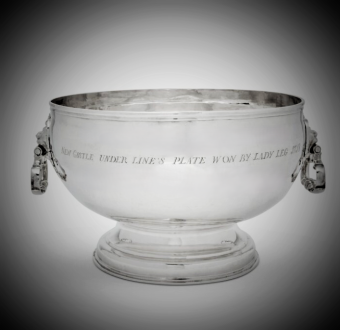Of plain circular shape with slightly bellied sides, applied with two cast lion mask and drop ring handles and raised on a large moulded spreading base. Britannia Standard with part marks on the handles
The Duke of Cervinara
Christies, London, 26th November, 1941, Lot 67, Puchased by Butterwick, Possibly (James) Cyril Butterwick
Walter Wilson, Circa 1932
Property of a Lady, Sotheby's, March 24th, 1960, lot 17, sold to Asprey for £1600
How of Edinburgh, Invoice dated June 7th 1979 to Richard Meech, QC., 1893-1990
Thence by descent to his son Richard Meech, 1921-2007
A Gift to a Private Collector
Exhibited
The Art treasures Exhibition, 1932, No.561 to Walter H. Wilson (Walter Wilson, silver dealer)
Please contact us for further information
The mis-spelling of Newcastle under Lyme is entirely plausible, partly due to the lack of standardization of spelling at that time and probably the engraver's interpretation of what should have been there. As far back as 1145 a new castle was built in the proximity of the Forest of Lyme but today this anomaly in spelling would be put down as a "typo". Despite much research we have been unable to identify more about this race which pre-dates official horse racing in the town by 10 years; similarly our researches have not found any information about the horse "Lady Leg".
This is a classic piece of English silver by a non-Huguenot maker. All the hammer marks are still visible from when the bowl was raised up from a flat sheet. The cast handles are a good size attached to bold lion masks, the colour and patination are excellent and the marks are very clear.
The bowl was part of one of the great collections of English silver in Canada belonging to the second Richard Meech whose family emigrated to that country in 1921 when he was just 6 months old. He was so proud of the bowl that it featured prominently in one of his Christmas cards.
The earliest punch bowl seems to be that belonging to the Worshipful Company of Drapers dated 1680 but within 4 years the adaptation of a wavy rim to support glasses manifested itself into what became known as the "Monteith". Curiously far more monteiths survive than punch bowls although those which had detachable rims, a feature devoped from about 1682 onwards, are often found without these additions. Perhaps one of the reasons for the scarcity of good 18th century punch bowls was due to the Victorians' predilection for profuse decoration. Many a plain piece of 18th century silver was re-fashioned to suit 19th century tastes and large items like punch bowls were targeted for such treatment. Evidence of this is supported by a significant number of de-chased bowls that have appeared on the market over the last 50 years, usually with poor colour and patination and bogus armorials. Similarly, one suspects that less care was taken over cleaning and polishing a plain bowl as opposed to an ornate one where greater care would have been necessary. Consequently, a great punch bowl in original condition has become one of the hardest things to find in English silver. The use of handles seems to be fairly random and the lack of marks on the handles of many bowls should always be treated with caution. It is fair to say that those made before 1700 are unlikely to be marked on the handles but after this date one would expect to see a lion's head erased if made during the compulsory britannia standard period (1697-1720) or a lion passant from 1720 onwards.
The size and weight of this bowl is wonderful and the fact it was given as a race prize in the year it was manufactured says a lot for the sponsor and the race itself. The maker, Seth Lofthouse, was the son of Alvara Lofthouse and entered his first mark in 1699 although we know he was working in 1697 in Bishopsgate having been apprenticed to William Wakefield in 1676. He appears top have died in 1722.

